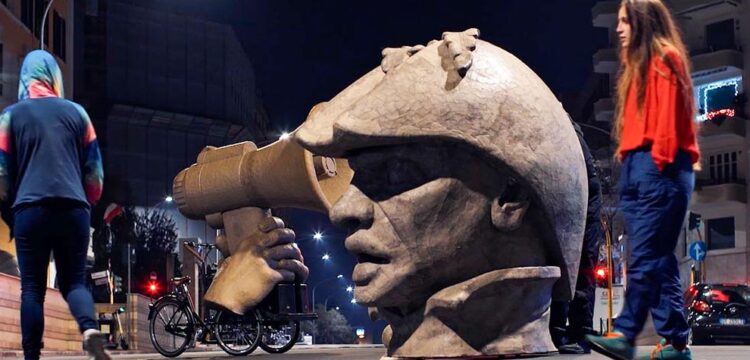EUR Charade
Marta Federici in conversation with Stalker (Giulia Fiocca, Lorenzo Romito)
Opening Hidden Histories 2021, on June 16th, Stalker crossed the streets of the EUR area on a mission to re-read the complicated historical and ideological heritage which still shadows the modern and contemporary buildings of a district designed by the fascist regime at the end of the 1930s. The following conversation, held in May, during a visit at the MuCiv – Museo delle Civiltà, introduces their intervention, deepening some of Stalker’s main themes and retracing the numerous experiences and actions presented by the collective at EUR, from the late 1990s onwards. Stalker’s words trace a path between streets and buildings and invite readers to re-evaluate the complexities and contradictions that characterize this district, without neglecting the prospect of hope, possibility, and transformation. The concept of EUR(H)OPE embodies this desire for openness and reimagines EUR as a meeting place in the heart of the Mediterranean: a welcoming and metaphorical meeting point for the different cultures that surround its shores.
Hidden Histories is a site-specific public program, consisting of performances, workshops, talks and urban explorations, meant to reflect on the cultural and historical heritage of Rome from a decolonial perspective. Conceived and curated by LOCALES, a curatorial platform founded in Rome by Sara Alberani and Valerio Del Baglivo, the project has just opened its second edition, which will run until the end of September and will present interventions by Stalker, bankleer, Josèfa Ntjam, Leone Contini and Daniela Ortiz.
Over the upcoming months, a series of interviews conducted by Marta Federici with the artists participating in HH 2021 will explore the issues addressed by the artistic interventions, in order to provide a broader context for each.
Marta Federici: Over the last few years, EUR has been one of your hot topics. When did your artistic practice first meet this territory?
Lorenzo Romito: I used to go to school in the EUR district, at the Liceo Classico Francesco Vivona. It was wonderful to skip school and have the whole EUR at my disposal. It is truly a metaphysical space. My first artistic activity in EUR dates to when I was about 18 years old, at the Super Sonic nightclub in via Crescenzio. The work was called Monumental Metamorphoses and consisted of photographs depicting the encounter between bodies and architecture. It was a very naive work, yet very relevant to my early fascination for this place.
Until the 1980s, the EUR area was a truly unique place in Rome. They used to take good care of the gardens and buildings; it was considered a right-wing district, but that care to keep it tidy was unique in the city. It used to have an autonomous, strongly claimed management. In 1991/1992, immediately after the occupation of the Department of Architecture in Rome during the Panther movement—a particularly creative moment—I presented a project about EUR during a university exam: a two-meter-long Plexiglas model, of the staircase and the Square Colosseum (also known as Palazzo della Civiltà del Lavoro), and the shadows of the arches illuminated from within. We had imagined EUR as an abstract city, in which one could project all the cities of the world. In those years, we did not use Photoshop, so the work was a series of overlapping slides. Through those screenings, the whole EUR district was transformed into a world city. That particular moment is stuck in my head—the idea that this district—situated between the city and the sea—could be a meeting place. The connections between Rome and the Mediterranean must pass by this place, and its museums, which are still longing to find their own coherence.
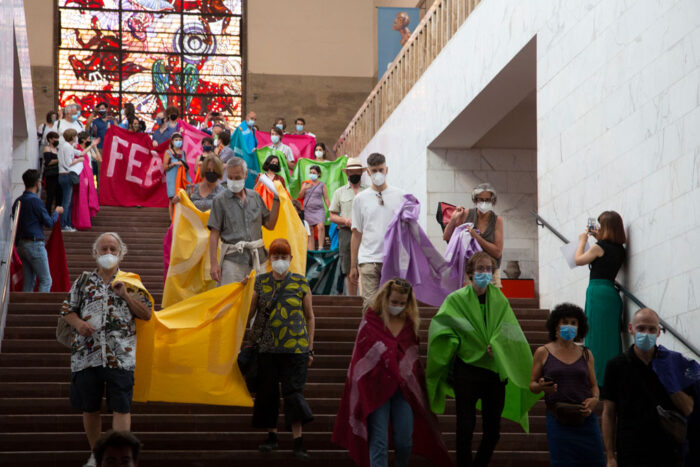
In the following years, from 1995 until today, Stalker has crossed the streets of EUR several times.
Giulia Fiocca: Yes. For example, in 2014 we worked at EUR together with a Danish artist, Maj Hasager, who was carrying on research about the district, and the Philippine community that gathers at the lake each Thursday afternoon. It was towards the end of her residence in Rome that we organized a walk together, inviting other artists as well. We traced a path between the columns of the MuCiv, animating our intervention with a long red thread that tied us to the place.
We crossed the EUR premises also previously, in 2008, during a workshop with some students from Delft, with whom we toured the Roma camps of Rome aboard nine recreational vehicles. We slept in some camps and learned from the Roma people about their community life and the way they build their houses which they then left for their hometowns in former Yugoslavia. However, when we reached the camp at Castel Romano, the situation became very tense and we were invited to find another place to sleep. We started wandering around southern Rome and, in the end, we decided to sleep at EUR, at Piazzale Agnelli, behind the MuCiv. And there we were, nine RVs and 40 architecture students from all around the world wandering at night along the district’s streets.
Lorenzo Romito: We also had the opportunity to cross the EUR area back in 1995, when from Tor Marancia, we passed through Tre Fontane and continued through the district.
Giulia Fiocca: And in 2016, during a three-day walk titled Sulle rovine del contemporaneo (On the ruins of the contemporary) from Colosseum to Calatrava’s Sail. On that occasion, we crossed the EUR district passing in front of Nuvola, which was still under construction at that time. In those days, you could still see Telecom’s “gutted” skyscrapers, as well as the site of the Velodrome, demolished in 2008/2009. The Velodrome’s structure contained asbestos and, when it was demolished, toxic dust dispersed into the air. In that area, there is still a sense of persisting void.
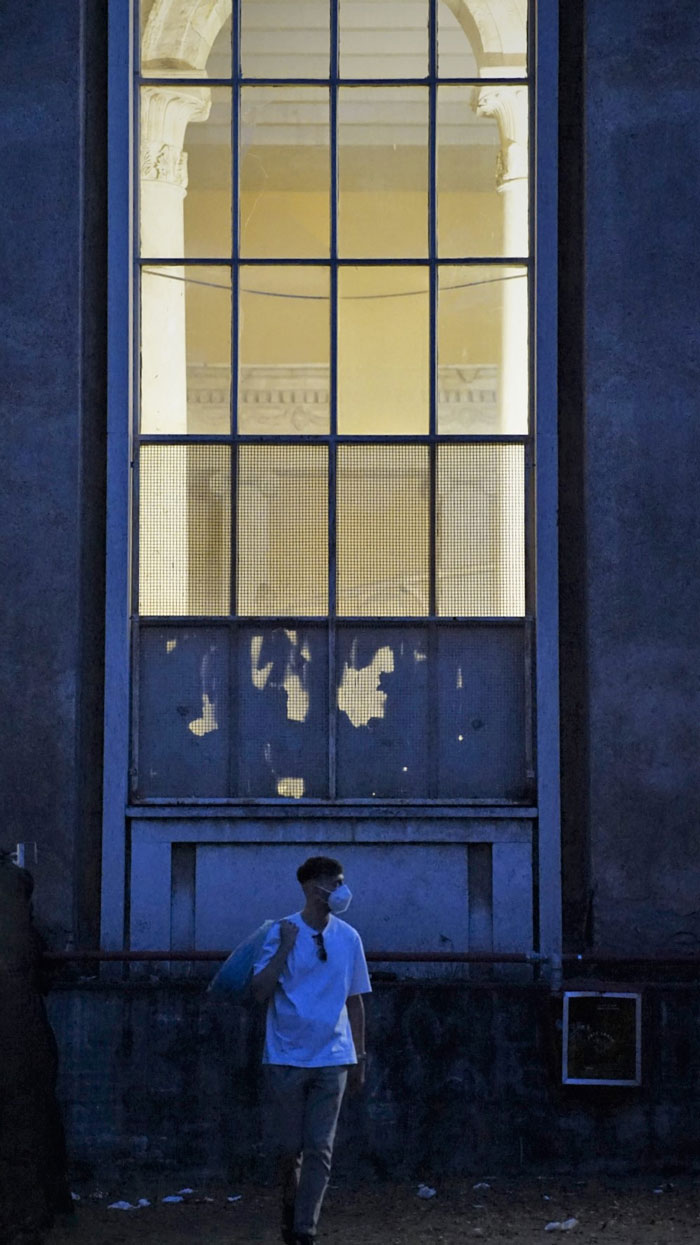
During your EUR intervention in 2014, you developed two concepts: Oceano Europa and Eur(h)ope. Can you tell us more about their meaning and their genesis?
Lorenzo Romito: 2014 was an important, yet dramatic year. It was somehow the year when the ideal perspective of Europe started to fade away. In 2014, Mare Nostrum—the Italian rescue operation for migrants attempting to cross the Mediterranean—was shut down and replaced by the so-called Europea Sophia, which was also terminated shortly after. The European Union and Italy gave up on the fundamental duty to save those who risk their lives at sea, while allowing, at the same time, the explicit financing of the concentration camps in Libya. We can say that 2014 marks the third great moment of rupture of the century, after the Twin Towers attack in 2001 and the financial crisis in 2008. It was in 2014 that I realized Europe was sinking. Thus, I decided to represent the state of things and combine it with a clear reference to the challenges related to climate change, and drew up Europe submerged up to the five-hundred-meter line: this is how the concept of Oceano Europa took shape. However, being neither pessimistic nor cynical by nature, I left room for the possibility and urgency of reaction. By adding a simple h to the word Europe, I outlined Eur(h)ope as a prospect of hope: the hope of regaining something that was no longer there. In those days, I began to reflect on the meaning of “Europe”. From a mythological point of view, Europe represents, first of all, a desire for freedom; the freedom that drives a journey, also across the sea, and it is precisely this desire that ultimately determined the foundation of Europe. And if Europe exists, primarily in our desire, then being European means still nurturing this desire today. Europe is a continent that has been shaped by various crossings: the crossings of the Greeks (Nostoi – Odyssey); the medieval pilgrimage routes; the nineteenth-century crossing of the Grand Tour. The tracers of Europe were not borders but crossing lines. Based on this imagery, I wrote a letter inviting some friends to take a “boat” together and cross the Oceano Europa, along the railway lines. By some miracle, a few weeks later, my utopian idea became reality. While the front and the sea routes were being blocked, the Balkan route opened allowing for an “oceanic” crossing along the railway tracks in the Balkans, passing through Vienna, and so on… This was the context in which these two concepts were conceived.
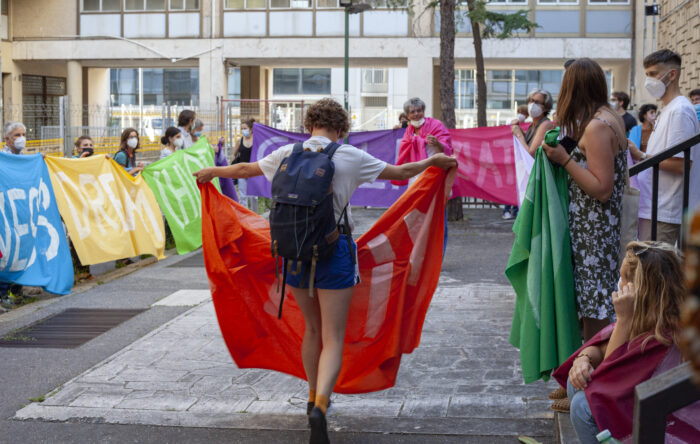
The EUR is located halfway between the city center and the Roman coast. Stretching out towards the sea, this district used to embody a very precise meaning in the Fascist agenda: the colonial and imperialist vision of the Mediterranean as an Italian “mare nostrum”, according to which Mussolini wanted to restore, from a modern and fascist perspective, the power of the ancient Roman Empire. How did you approach this absurd symbolic value embodied by EUR?
Lorenzo Romito: Our intention was not to cancel but to reinterpret it. It was thus necessary to reverse the symbolism of the relationship with the sea. For us, EUR reaches out to the sea to enhance its status of meeting place at the center of the Mediterranean, and among its different shores: Europe, Africa, and Asia. EUR is situated on the road that leads to the sea as a great metaphysical invention, but also as a great ruin. As often happens in Rome, great ideas are transformed into ruins, which then become the starting point for unpredictable events. As Luigi Squarzina recalls in a play titled The Universal Exposition, immediately after the war, many refugees came to live in these ruins for a short period time.
From 1960 onwards, EUR began its second life, representing a rather unique case of expropriated public space and becoming the headquarter of different public offices and ministries. Then, due to the 2007/2008 financial crisis, that zest was curbed again. Nuvola is one of those places that clearly expresses the media and social function of the starchitect myth– a tool in the hands of certain economic powers. These are the typical buildings that can plunge public management into debt. I do believe that contemporary architecture is the most effective tool to put public administration in debt and ultimately trigger a process of privatization of services. EUR became a symbol. It was this type of mechanism that led EUR to bankruptcy, constraining the rental of the public buildings to private individuals, as in the case of the State Archives. A very perverse mechanism, which transformed EUR in a large inefficient periphery, an infinite construction site. Nowadays, its gardens are almost abandoned.
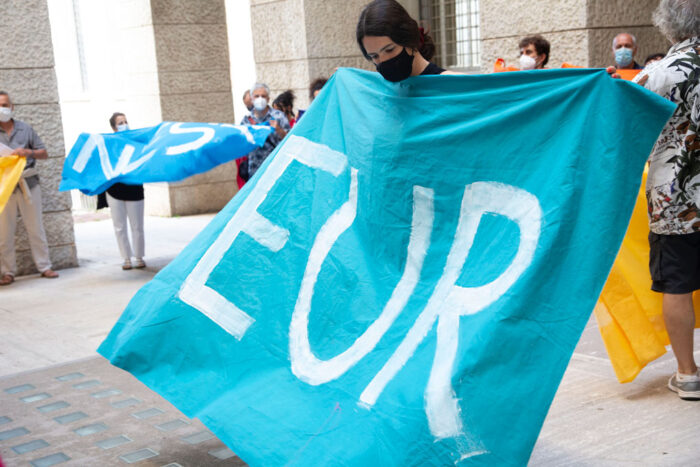
In short, we can say that, up to now, EUR has cyclically repeated that transformation from monument to ruin throughout different historical moments.
Lorenzo Romito: Yes, traces of different phases of the city’s history can be found in the EUR district. Everything in Rome has a monumental character, even the suburbs; Corviale is monumental in its own way. This monumentality carries with it not only the trace of the ideological failures of modern society which often misinterprets its own historic time, but also the signs of a government that together with being incapable of designing a human-sized city, is actually favoring monumental and bankrupt operations. It was on these ruins that Rome found its way to resurrection, following paths that are not institutional, but rather spontaneous.
I do not wish to antagonize the system because I feel it is an unequal struggle. It is a system that already reveals its limits by itself. To me, it is more important to re-signify the values and nurture a certain desire for a different society than to generate conflicts. The current system is so pervasive that we must first decolonize ourselves, our behaviors, our consumption habits, our ways of living.
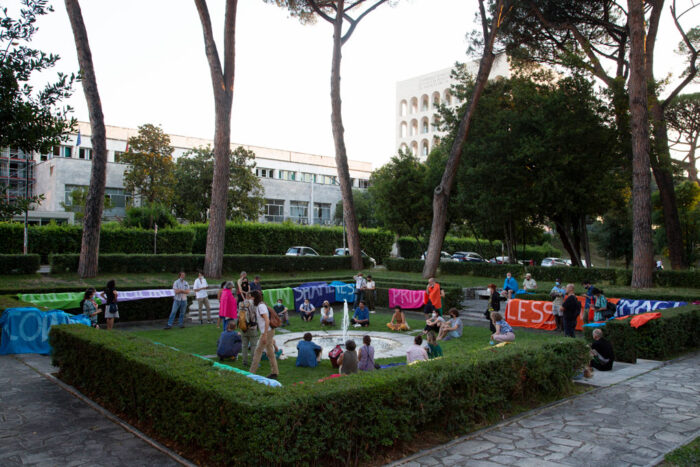
The title you are imagining for the walk on June 16th is EUR(H)OPE Charade. Why did you choose this term, and what are you doing in preparation of this new crossing action?
The English term “charade” fascinates us for several reasons, first, because it is characterized by a certain ambiguity, necessary for a project designed for a reality as complicated and ambiguous as that of the EUR. The ambiguity lies in the word’s double meaning, which can also mean “staging”.
The meaning of “staging” is connected to how Stalker plays with the very idea of performance, and our years-long attempt to overcome the boundaries of this notion. From this point of view, charade means that we recognize ourselves in a staging. But, at the same time, it entails that we recognize the different kinds of staging implemented by the arrogant magniloquence of EUR’s urban planning and architecture. In our second reading of the word charade, we refer instead to a linguistic game – the charade – which announces our desire to explore this territory using language in a playful and ironic way.
As we were saying before, we are in a suspended condition, where Europe is presented today as the desire for something that no longer exists, and the word hope is becoming increasingly impractical. The (de)composition of the word Eur-(h)ope emerges before our eyes as the basic principle, a starting point. We want to try to imagine new ways of working with language, to explore its contradictions, to consume it. Our proposal is therefore to use the combinatory art of charades to mediate the encounter with the metaphysical—yet assertive—architectures that articulate the EUR. English lends itself very well to this kind of operation, due to the modular structure of some of its words. We have painted colored sheets with words and fragments of words that participants will be able to spontaneously recombine during the walk.
But there is more: the term charade is also phonetically close to the term parade, aka procession. We thus imagine a population in procession, a population that is not there, that does not recognize itself, and that wanders in a space that continuously transits to another time.
Stalker was born in 1995, you have almost thirty years of history behind you. How would you describe your work to someone who does not know you?
Lorenzo Romito: I would say that Stalker is mainly a meeting point for different people and spaces. It is something that is inevitably a bit unpredictable—otherwise, it would just be a mere spectacle. In that unpredictability, a collective emotion—a vibration—is captured: and that, for me, means Stalker. A happy, harmonious encounter between people and places, through the action of walking. Stalker is not a person, a subject, or a thought, but rather a way to grasp aspects around us that are not necessarily evident. It is also a way of putting aside that authorship and self-reference befitting the solitary and brilliant artist, so easily exploited by power. For Stalker, the creative act is a collective awareness that is sometimes ironic and witty; it is a reappropriation of the relationship with a place, the discovery of some of the memories hidden there, the identification of possible imaginaries and ways of using them. It is behavioral urban planning, a gestural architecture, energy that regenerates places through interpretation.
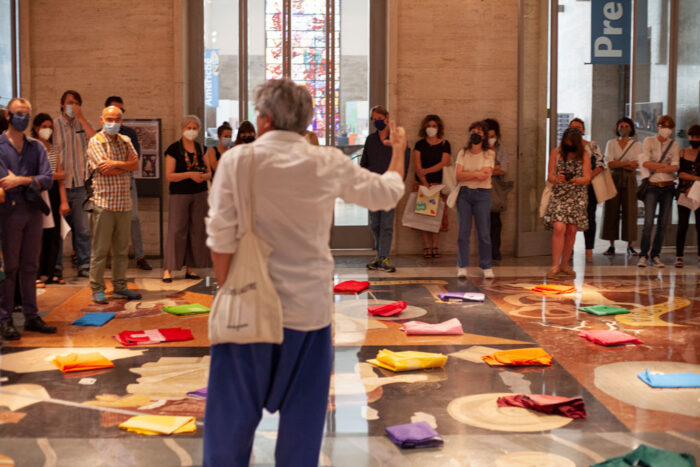
Your practice is mainly based on the action of walking and crossing urban areas. What is the significance of this practice in a historical moment as the present one, and after several months in which it was not possible to use the public space? How did Stalker experience this period?
Giulia Fiocca: We have continued to do what we always do, even in the “orange” zone. We worked hard so that these actions of crossing the public space could continue in complete safety, even in a period in which, partly because of the restrictions and partly for personal choice or civic sense, it was not easy to be outdoors. It was important for us to keep this desire alive. In Rome, many different spaces are accessible, why not use them? Last year, we wanted to do the same thing in schools, but it did not work out. Doing lessons outdoors has always been a recurrent practice, but now we are trying to do it even more, starting from the enhancement of the spatiality and geography of our city.
Lorenzo Romito: On the last day of the first lockdown, I wrote a call inviting everyone in Piazza del Popolo, to get a feeling of this deserted city and seize the possibility of meeting just before it became possible. More recently, we wrote another call on comune.info, launching the idea of Rome as a city that lives outdoors: Roma, città all’aperto. The psychosis of confinement does not help us to enhance a sense of responsibility but rather triggers a sort of behavioral normativity that is sometimes paradoxical. In a city like Rome, with its spaces, its open-air cinemas, and theaters, we can imagine infinite ways of being together.
Let’s open up the city, let’s take back the public space, let’s use it as a lab to understand what we can do with it after this pandemic, let’s create moments of encounter in the city that allow us to disseminate that sense of awareness, re-appropriation, and care for the collective space. As Giulia said, we have never stopped. We try to do everything we can. For us, the act of crossing the city means also getting around the obstacle, encircling it.


